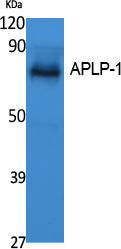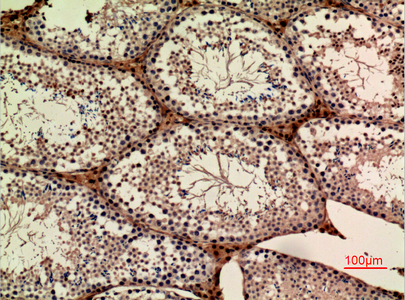APLP-1 Polyclonal Antibody
- Catalog No.:YT5058
- Applications:WB;IHC;IF;ELISA
- Reactivity:Human;Mouse
- Target:
- APLP-1
- Gene Name:
- APLP1
- Protein Name:
- Amyloid-like protein 1
- Human Gene Id:
- 333
- Human Swiss Prot No:
- P51693
- Mouse Gene Id:
- 11803
- Mouse Swiss Prot No:
- Q03157
- Immunogen:
- Synthesized peptide derived from APLP-1 . at AA range: 360-440
- Specificity:
- APLP-1 Polyclonal Antibody detects endogenous levels of APLP-1 protein.
- Formulation:
- Liquid in PBS containing 50% glycerol, 0.5% BSA and 0.02% sodium azide.
- Source:
- Polyclonal, Rabbit,IgG
- Dilution:
- WB 1:500 - 1:2000. IHC: 1:100-300 ELISA: 1:10000.. IF 1:50-200
- Purification:
- The antibody was affinity-purified from rabbit antiserum by affinity-chromatography using epitope-specific immunogen.
- Concentration:
- 1 mg/ml
- Storage Stability:
- -15°C to -25°C/1 year(Do not lower than -25°C)
- Other Name:
- APLP1;Amyloid-like protein 1;APLP;APLP-1
- Observed Band(KD):
- 72kD
- Background:
- This gene encodes a member of the highly conserved amyloid precursor protein gene family. The encoded protein is a membrane-associated glycoprotein that is cleaved by secretases in a manner similar to amyloid beta A4 precursor protein cleavage. This cleavage liberates an intracellular cytoplasmic fragment that may act as a transcriptional activator. The encoded protein may also play a role in synaptic maturation during cortical development. Alternatively spliced transcript variants encoding different isoforms have been described. [provided by RefSeq, Jul 2008],
- Function:
- domain:The NPXY sequence motif found in many tyrosine-phosphorylated proteins is required for the specific binding of the PID domain. However, additional amino acids either N- or C-terminal to the NPXY motif are often required for complete interaction. The NPXY site is also involved in clathrin-mediated endocytosis.,function:May play a role in postsynaptic function. The C-terminal gamma-secretase processed fragment, ALID1, activates transcription activation through APBB1 (Fe65) binding (By similarity). Couples to JIP signal transduction through C-terminal binding. May interact with cellular G-protein signaling pathways. Can regulate neurite outgrowth through binding to components of the extracellular matrix such as heparin and collagen I.,function:The gamma-CTF peptide, C30, is a potent enhancer of neuronal apoptosis.,miscellaneous:Binds zinc and copper in the extracellular domain. Zinc-
- Subcellular Location:
- Cell membrane; Single-pass type I membrane protein.; [C30]: Cytoplasm. C-terminally processed in the Golgi complex.
- Expression:
- Expressed in the cerebral cortex where it is localized to the postsynaptic density (PSD).
- June 19-2018
- WESTERN IMMUNOBLOTTING PROTOCOL
- June 19-2018
- IMMUNOHISTOCHEMISTRY-PARAFFIN PROTOCOL
- June 19-2018
- IMMUNOFLUORESCENCE PROTOCOL
- September 08-2020
- FLOW-CYTOMEYRT-PROTOCOL
- May 20-2022
- Cell-Based ELISA│解您多样本WB检测之困扰
- July 13-2018
- CELL-BASED-ELISA-PROTOCOL-FOR-ACETYL-PROTEIN
- July 13-2018
- CELL-BASED-ELISA-PROTOCOL-FOR-PHOSPHO-PROTEIN
- July 13-2018
- Antibody-FAQs
- Products Images

- Western Blot analysis of extracts from K562 cells, using APLP-1 Polyclonal Antibody. Secondary antibody(catalog#:RS0002) was diluted at 1:20000

- Immunohistochemical analysis of paraffin-embedded mouse-ovary, antibody was diluted at 1:100



